Modeling and Analyzing the Impact of Different Operating Conditions for Electric and Conventional Vehicles in Malaysia on Energy, Economic, and the Environment
Abstract
1. Introduction
1.1. Factors Affecting Energy Consumption
1.2. Electric Vehicle Energy Consumption Modeling
2. Methodology
2.1. Modeling the Route for Different Scenarios
2.1.1. Scenario 1: Long-Distance Highway Route
2.1.2. Scenario 2: Short-Distance Highway Route
2.1.3. Scenario 3: Long-Distance Urban Route
2.1.4. Scenario 4: Short-Distance Urban Route
2.1.5. Scenario 5: Long-Distance Suburban Route
2.1.6. Scenario 6: Short-Distance Suburban Route
2.2. Speed
2.3. Time and Weather
2.4. Cost
2.5. Carbon Dioxide Emission
2.6. Internal Combustion Engine Vehicle Petrol Consumption Model
- F1:
- The petrol consumption rate, in liters per 100 km, for vehicles traveling at a constant speed of 90 km/h
- F2:
- The fuel consumption rate, in liters per 100 km, for vehicles traveling at a constant speed of 120 km/h
- Fi:
- The petrol consumption rate for idling vehicles in m/s
- Fd:
- The petrol consumption rate for decelerating vehicles in mL/s
- C1 and C2:
- The two constants in the equation for the fuel-consumption rate for accelerating vehicles, in mL/s and in ml s2/m2
- Vm:
- The speed at which the fuel-consumption rate, in mL/s, is at a minimum for a vehicle cruising at a constant speed
2.7. Electric Vehicle Energy Consumption Model
2.8. Pollutant Emission
2.9. Vehicle Weight
2.10. Simulation Results Validation
3. Results and Discussion
3.1. Energy Consumption Impact of Different Route Conditions
3.2. Economic Impact of Different Route Conditions
3.3. Environmental Impact on Different Route Conditions
3.4. Overall Comparison of the Different Scenarios
3.5. Validation Result
4. Conclusions
Author Contributions
Funding
Data Availability Statement
Conflicts of Interest
References
- Abdul Razak, N.A.; Ismail, R.; Abdul Hakim, R. Is There a Case for Fuel Subsidy Removal in Malaysia? J. Econ. Financ. Stud. 2014, 2, 1–13. [Google Scholar] [CrossRef]
- Moody, J.; Farr, E.; Papagelis, M.; Keith, D.R. The value of car ownership and use in the United States. Nat. Sustain. 2021, 4, 769–774. [Google Scholar] [CrossRef]
- U.S. Department of Energy. All-Electric Vehicles. Available online: https://www.fueleconomy.gov/feg/evtech.shtml (accessed on 20 December 2022).
- Treiber, M.; Kesting, A.; Thiemann, C. How Much does Traffic Congestion Increase Fuel Consumption and Emissions? Applying a Fuel Consumption Model to the NGSIM Trajectory Data. In Proceedings of the 87th Annual Meeting of the Transportation Research Board, Washington, DC, USA, 13–17 January 2007. [Google Scholar]
- Massachusetts Institute of Technology (MIT CSHub). The Impact of Traffic Jams on PVI Estimates. 2015. Available online: https://cshub.mit.edu/sites/default/files/documents/3%20CSHub%20Research%20Brief%20-%20Iss.%203%202015%20-%20PVI%20Velocity%20Distributions.pdf (accessed on 2 February 2023).
- Burlando, C.; Ivaldi, E.; Parra Saiani, P.; Penco, L. To own or not to own? Car ownership and consumer awareness: Evidence from an Italian survey. Res. Transp. Bus. Manag. 2019, 33, 100435. [Google Scholar] [CrossRef]
- Tenaga, S. Malaysia Energy Statistics Handbook 2020; Energy Commission: Putrajaya, Malaysia, 2020.
- Teixeira, A.C.R.; Sodré, J.R. Impacts of replacement of engine powered vehicles by electric vehicles on energy consumption and CO2 emissions. Transp. Res. Part D Transp. Environ. 2018, 59, 375–384. [Google Scholar] [CrossRef]
- Aasness, M.A.; Odeck, J. The increase of electric vehicle usage in Norway—Incentives and adverse effects. Eur. Transp. Res. Rev. 2015, 7, 1–8. [Google Scholar] [CrossRef]
- Zacharof, N.G.; Fontaras, G.; Ciuffo, B.; Tsiakmakis, S.; Anagnostopoulos, K.; Marotta, A.; Pavlovic, J. Review of in Use Factors Affecting the Fuel Consumption and CO2 Emissions of Passenger Cars; Publications Office of the European Union: Luxembourg, 2016. [Google Scholar]
- Zhou, M.; Jin, H.; Wang, W. A review of vehicle fuel consumption models to evaluate eco-driving and eco-routing. Transp. Res. Part D Transp. Environ. 2016, 49, 203–218. [Google Scholar] [CrossRef]
- Alberto Barbado, Ó.C. Understanding Factors Affecting Fuel Consumption of Vehicles Through Explainable AI: A Use CaseWith Explainable Boosting Machines. 2021. Available online: https://www.researchgate.net/publication/353235325_Understanding_Factors_Affecting_Fuel_Consumption_of_Vehicles_Through_Explainable_AI_A_Use_Case_With_Explainable_Boosting_Machines (accessed on 3 February 2023).
- Miller, V. The Impact of Stopping on Fuel Consumption. 2011. Available online: http://large.stanford.edu/courses/2011/ph240/miller1/#:~:text=Therefore%2C%20each%20time%20a%20car,of%20one%20gallon%20of%20gasoline (accessed on 5 February 2023).
- Ronaldo, A. Comparison of the Two Microsimulation Software Aimsun & Sumo for Highway Traffic Modelling. 2012. Available online: https://www.diva-portal.org/smash/record.jsf?pid=diva2%3A555913&dswid=5354 (accessed on 21 February 2023).
- Mitroi, I.S.; Ciobîcă, A.M.; Popa, M. Car-Following Models Comparison between Models Used by VISSIM and AIMSUN. UPB Sci. Bull. Ser. D 2016, 78, 71–82. [Google Scholar]
- Lu, X.Y.; Lee, J.; Chen, D.; Bared, J.; Dailey, D.; Shladover, S.E. Freeway Micro-simulation Calibration: Case Study Using Aimsun and VISSIM with Detailed Field Data. In Proceedings of the 93rd Annual Meeting of the Transportation Research Board, Washington, DC, USA, 12–16 January 2014. [Google Scholar]
- Modi, S.; Bhattacharya, J. A system for electric vehicle’s energy-aware routing in a transportation network through real-time prediction of energy consumption. Complex Intell. Syst. 2022, 8, 4727–4751. [Google Scholar] [CrossRef]
- Barceló, J. Microscopic traffic simulation: A tool for the analysis and assessment of its systems. J. Intell. Robot. Syst. 2005, 41, 173–203. [Google Scholar] [CrossRef]
- Acuto, F.; Coelho, M.C.; Fernandes, P.; Giuffrè, T.; Macioszek, E.; Granà, A. Assessing the Environmental Performances of Urban Roundabouts Using the VSP Methodology and AIMSUN. Energies 2022, 15, 1371. [Google Scholar] [CrossRef]
- Muzir, N.A.Q.; Mojumder, M.R.H.; Hasanuzzaman, M.; Selvaraj, J. Challenges of Electric Vehicles and Their Prospects in Malaysia: A Comprehensive Review. Sustainability 2022, 14, 8320. [Google Scholar] [CrossRef]
- Asadi, S.; Nilashi, M.; Iranmanesh, M.; Ghobakhloo, M.; Samad, S.; Alghamdi, A.; Almulihi, A.; Mohd, S. Drivers and barriers of electric vehicle usage in Malaysia: A DEMATEL approach. Resour. Conserv. Recycl. 2022, 177, 105965. [Google Scholar] [CrossRef]
- Rahman, A.; Afroz, R.; Alam, A.Z. Development of electric vehicle: Public perception and attitude, the Malaysian approach. World Rev. Intermodal Transp. Res. 2014, 5, 149. [Google Scholar] [CrossRef]
- Sang, Y.-N.; Bekhet, H.A. Modelling electric vehicle usage intentions: An empirical study in Malaysia. J. Clean. Prod. 2015, 92, 75–83. [Google Scholar] [CrossRef]
- Ayodele, B.V.; Mustapa, S.I. Life Cycle Cost Assessment of Electric Vehicles: A Review and Bibliometric Analysis. Sustainability 2020, 12, 2387. [Google Scholar] [CrossRef]
- Salisa, A.R.; Walker, P.D.; Zhang, N.; Zhu, J.G. Comparative Cost-Based Analysis of a Novel Plug-in Hybrid Electric Vehicle with Conventional and Hybrid Electric Vehicles. Int. J. Automot. Mech. Eng. 2015, 11, 2262–2271. [Google Scholar] [CrossRef]
- Mamarikas, S.; Doulgeris, S.; Samaras, Z.; Ntziachristos, L. Traffic impacts on energy consumption of electric and conventional vehicles. Transp. Res. Part D Transp. Environ. 2022, 105, 103231. [Google Scholar] [CrossRef]
- André, M. The ARTEMIS European driving cycles for measuring car pollutant emissions. Sci. Total Environ. 2004, 334–335, 73–84. [Google Scholar] [CrossRef]
- Kara, S.; Li, W.; Sadjiva, N. Life Cycle Cost Analysis of Electrical Vehicles in Australia. Procedia CIRP 2017, 61, 767–772. [Google Scholar] [CrossRef]
- Xing, J.; Chu, L.; Guo, C. Optimization of Energy Consumption Based on Traffic Light Constraints and Dynamic Programming. Electronics 2021, 10, 2295. [Google Scholar] [CrossRef]
- Kosai, S.; Zakaria, S.; Che, H.S.; Hasanuzzaman, M.; Rahim, N.A.; Tan, C.; Ahmad, R.D.R.; Abbas, A.R.; Nakano, K.; Yamasue, E.; et al. Estimation of Greenhouse Gas Emissions of Petrol, Biodiesel and Battery Electric Vehicles in Malaysia Based on Life Cycle Approach. Sustainability 2022, 14, 5783. [Google Scholar] [CrossRef]
- Goetzel, N.; Hasanuzzaman, M. An empirical analysis of electric vehicle cost trends: A case study in Germany. Res. Transp. Bus. Manag. 2022, 43, 100825. [Google Scholar] [CrossRef]
- Zammit, E.; Convello, A.; Leone, C.; Longo, M.; Yaici, W.; Foiadelli, F. Cost and Emission Comparison of Long-Distance Travel and Life-Cycle for EV and ICE Vehicle: A Case Study. In Proceedings of the 2022 IEEE International Conference on Environment and Electrical Engineering and 2022 IEEE Industrial and Commercial Power Systems Europe (EEEIC/I&CPS Europe), Prague, Czech Republic, 28 June–1 July 2022; pp. 1–6. [Google Scholar]
- Travesset-Baro, O.; Rosas-Casals, M.; Jover, E. Transport energy consumption in mountainous roads. A comparative case study for internal combustion engines and electric vehicles in Andorra. Transp. Res. Part D Transp. Environ. 2015, 34, 16–26. [Google Scholar] [CrossRef]
- Ahn, K.; Park, S.; Rakha, H.A. Impact of Intersection Control on Battery Electric Vehicle Energy Consumption. Energies 2020, 13, 3190. [Google Scholar] [CrossRef]
- Jonas, T.; Wilde, T.; Hunter, C.D.; Macht, G.A.; Aifadopoulou, G. The Impact of Road Types on the Energy Consumption of Electric Vehicles. J. Adv. Transp. 2022, 2022, 1–14. [Google Scholar] [CrossRef]
- Wu, X.; Freese, D.; Cabrera, A.; Kitch, W.A. Electric vehicles’ energy consumption measurement and estimation. Transp. Res. Part D Transp. Environ. 2015, 34, 52–67. [Google Scholar] [CrossRef]
- Malaysia, Ministry of Transport. Transport Statistics Malaysia 2021; Ministry of Transport: Putrajaya, Malaysia, 2022.
- Hawkins, T.R.; Singh, B.; Majeau-Bettez, G.; Strømman, A.H. Comparative Environmental Life Cycle Assessment of Conventional and Electric Vehicles. J. Ind. Ecol. 2012, 17, 53–64. [Google Scholar] [CrossRef]
- Agency, U.S.E.P. (Office of Transportation and Air Quality, United States Environmental Protection Agency). Greenhouse Gas Emissions from a Typical Passenger Vehicle; Agency, U.S.E.P.: Washington, DC, USA, 2018.
- Brander, M.; Sood, A.; Wylie, C.; Haughton, A.; Lovell, J. Electricity-specific emission factors for grid electricity. Ecometrica 2011. Available online: https://ecometrica.com/assets/Electricity-specific-emission-factors-for-grid-electricity.pdf (accessed on 3 February 2023).
- Fazil, A.D.M.; Fawzi, M.; Osman, S.A.; Ismail, M.M.; Said, M.F.M. Potential Consumer Assessment on the Usage of Diesel-CNG Dual Fuel Vehicle in Malaysia. J. Adv. Res. Fluid Mech. Therm. Sci. 2019, 53, 175–184. [Google Scholar]
- Aimsun. Fuel Consumption Model. Available online: https://docs.aimsun.com/next/22.0.1/UsersManual/EnvironmentalModels.html (accessed on 21 February 2023).
- Haaren, R.v. Assessment of Electric Cars’ Range Requirements and Usage Patterns based on Driving Behavior recorded in the National Household Travel Survey of 2009; Earth and Environmental Engineering Department, Columbia University, Fu Foundation School of Engineering and Applied Science: New York, NY, USA, 2011. [Google Scholar]
- Larminie, J.; Lowry, J. Electric Vehicle Technology Explained; John Wiley & Sons: Hoboken, NJ, USA, 2003. [Google Scholar]
- Genikomsakis, K.N.; Mitrentsis, G. A computationally efficient simulation model for estimating energy consumption of electric vehicles in the context of route planning applications. Transp. Res. Part D Transp. Environ. 2017, 50, 98–118. [Google Scholar] [CrossRef]
- Iora, P.; Tribioli, L. Effect of Ambient Temperature on Electric Vehicles’ Energy Consumption and Range: Model Definition and Sensitivity Analysis Based on Nissan Leaf Data. World Electr. Veh. J. 2019, 10, 2. [Google Scholar] [CrossRef]
- Int Panis, L.; Broekx, S.; Liu, R. Modelling instantaneous traffic emission and the influence of traffic speed limits. Sci Total Env. 2006, 371, 270–285. [Google Scholar] [CrossRef] [PubMed]
- Chalermwongphan, K.; Upala, P. Comparing the Traffic Operation, Fuel Consumption, and Pollutant Emission of Bike Lane Pattern Design with AIMSUN Microscopic Simulation Model: A Case Study of Nakhon Sawan Municipality in Thailand. Open Transp. J. 2019, 13, 182–193. [Google Scholar] [CrossRef]
- Boriboonsomsin, K.; Barth, M. Impacts of Road Grade on Fuel Consumption and Carbon Dioxide Emissions Evidenced by Use of Advanced Navigation Systems. Transp. Res. Rec. J. Transp. Res. Board 2009, 2139, 21–30. [Google Scholar] [CrossRef]
- U.S. Department of Energy. Average Fuel Consumption at Increasing Road Grades. 2014. Available online: https://afdc.energy.gov/data/ (accessed on 30 December 2022).
- Neves, A.; Brand, C. Assessing the potential for carbon emissions savings from replacing short car trips with walking and cycling using a mixed GPS-travel diary approach. Transp. Res. Part A Policy Pract. 2019, 123, 130–146. [Google Scholar] [CrossRef]
- Agency U.S.E.P. Routes to Lower Greenhouse Gas Emissions Transportation Future. 2022; [cited 2023]. Available online: https://www.epa.gov/greenvehicles/routes-lower-greenhouse-gas-emissions-transportation-future (accessed on 27 February 2023).
- Heinen, E.; Mattioli, G. Multimodality and CO2 emissions: A relationship moderated by distance. Transp. Res. Part D Transp. Environ. 2019, 75, 179–196. [Google Scholar] [CrossRef]
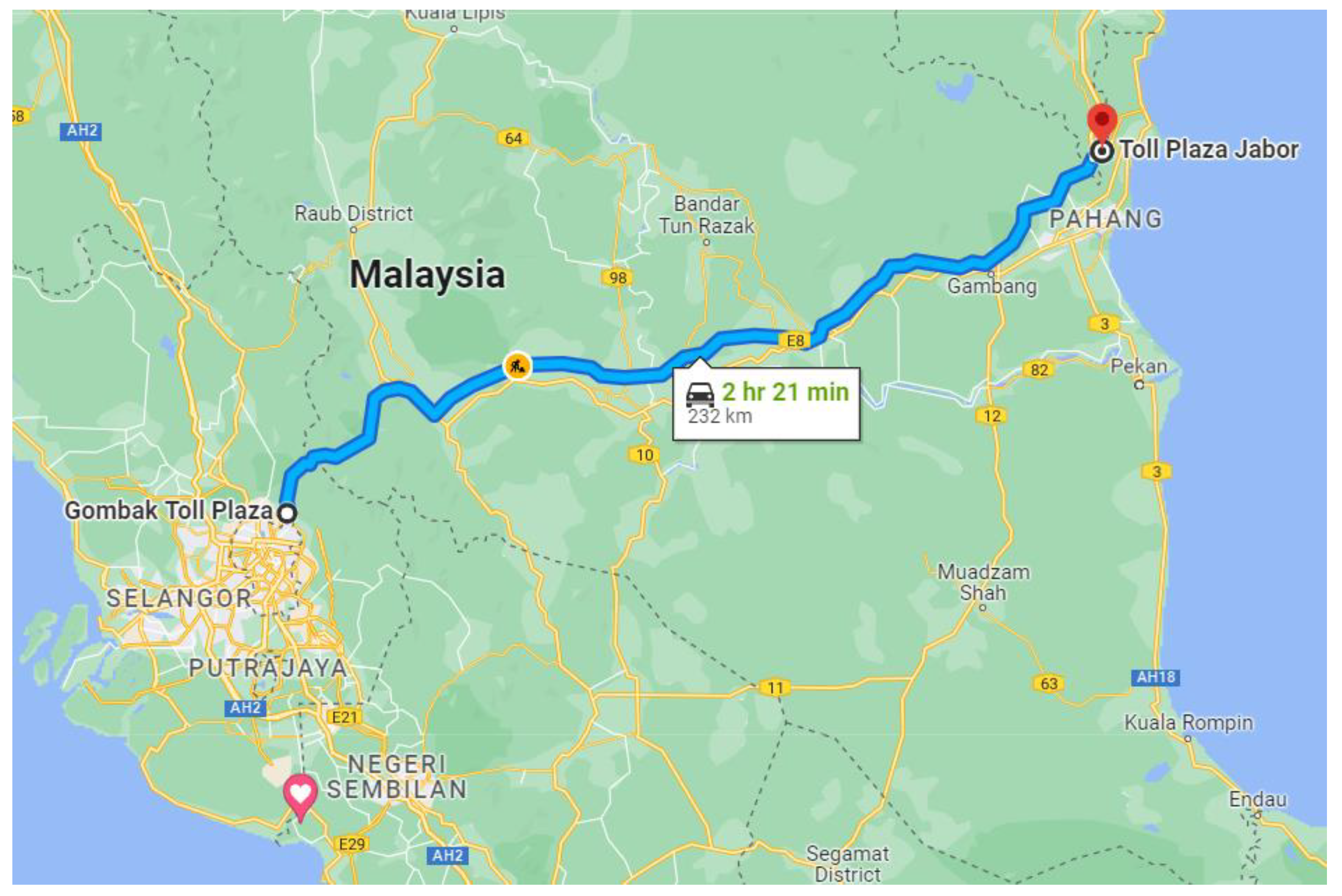
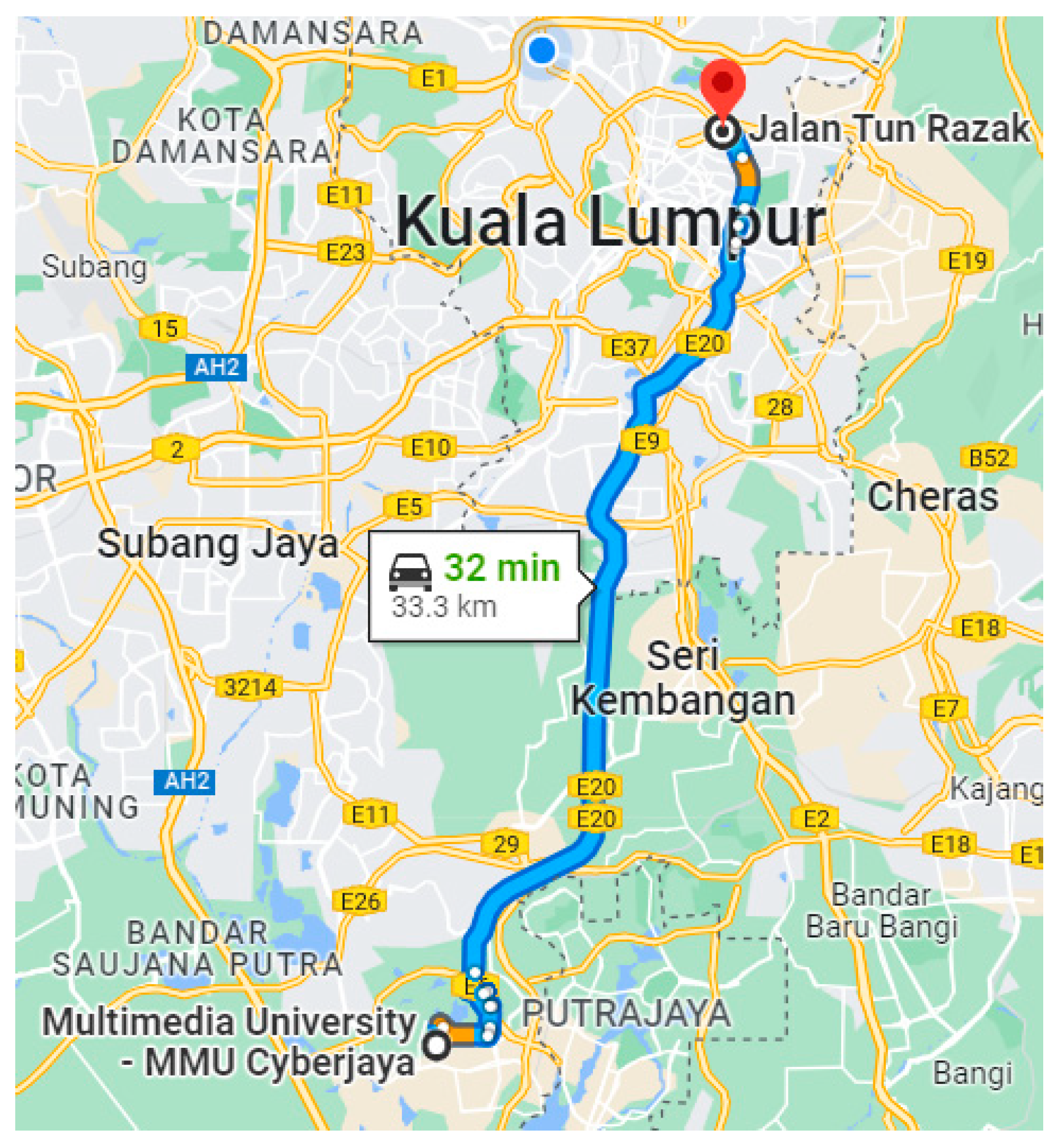

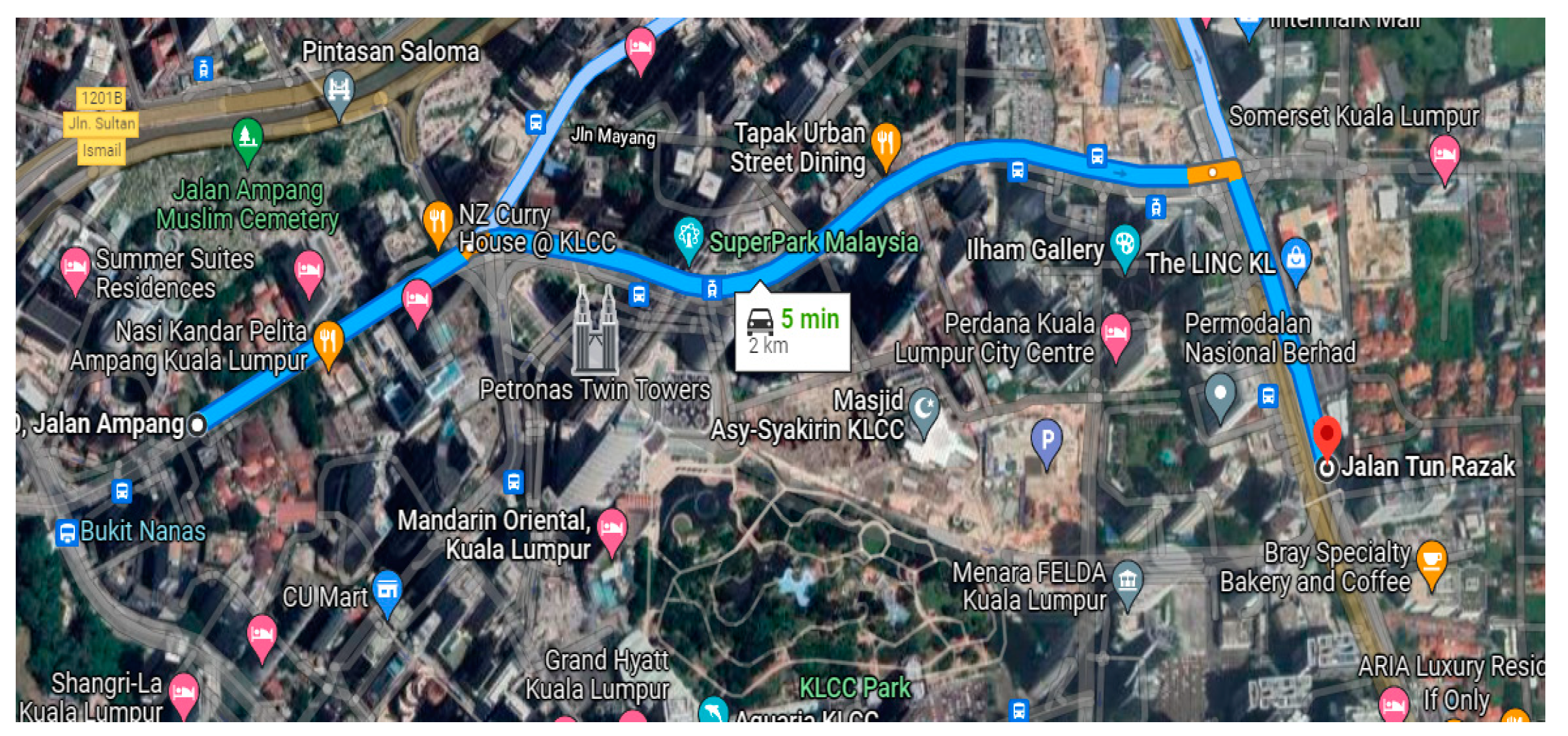
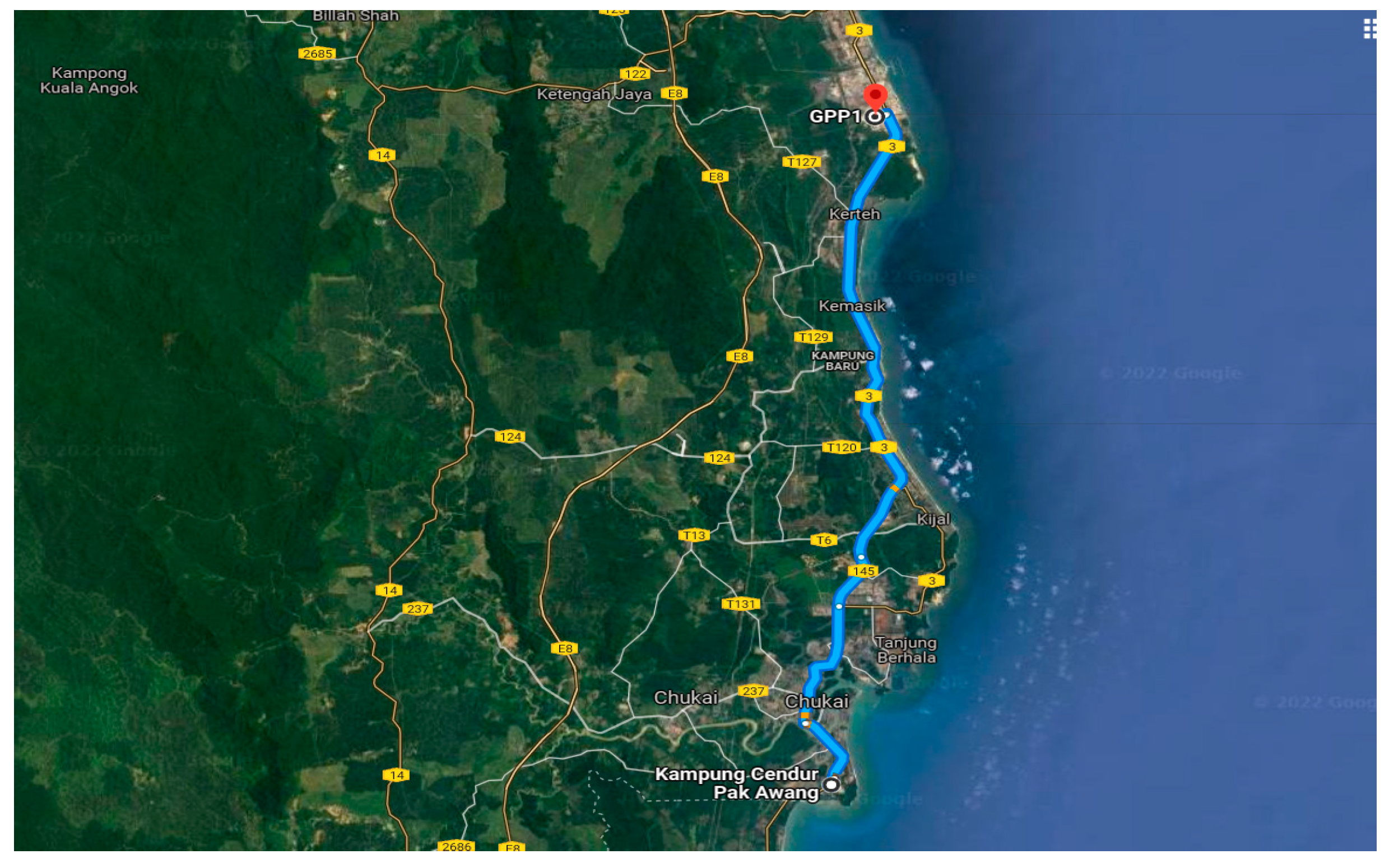
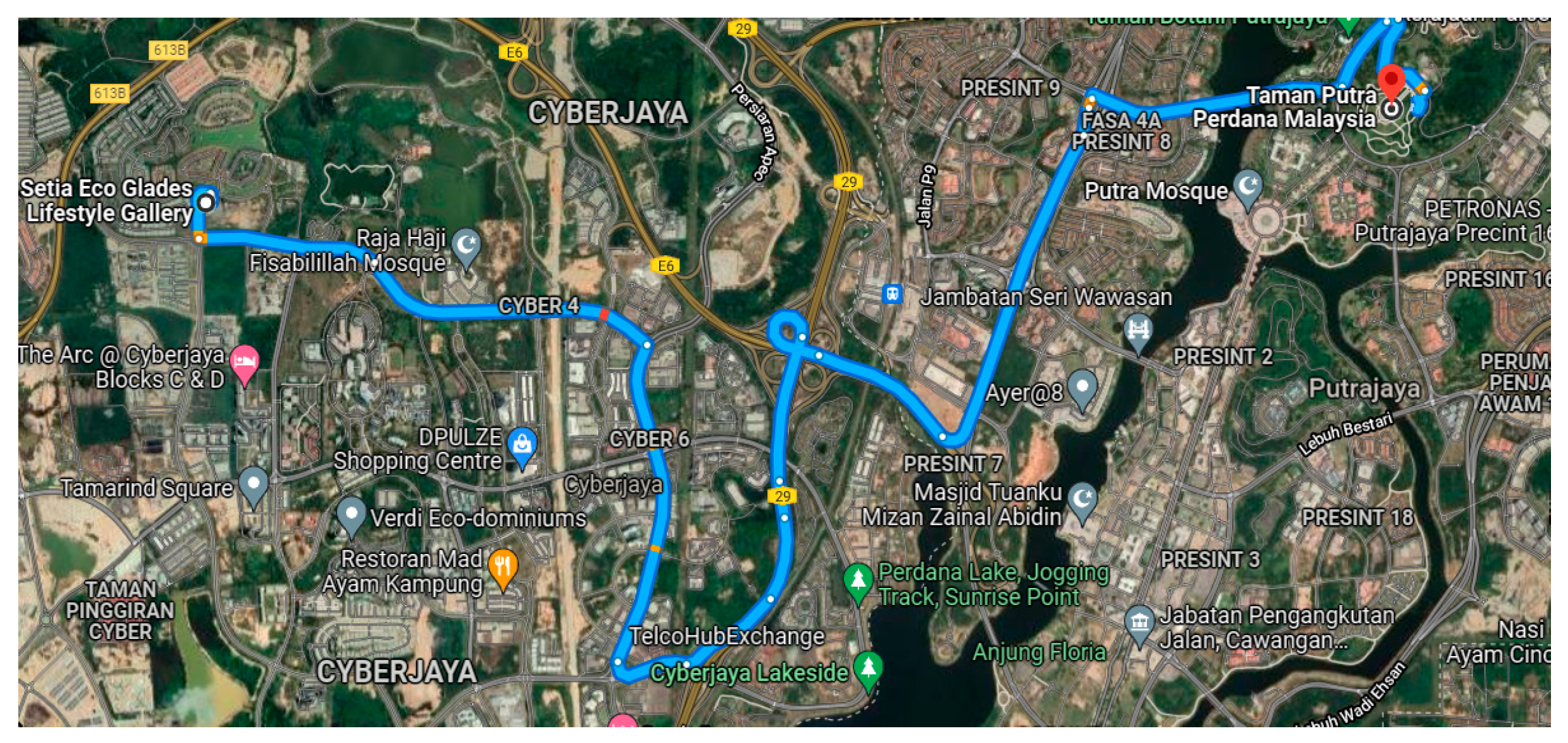
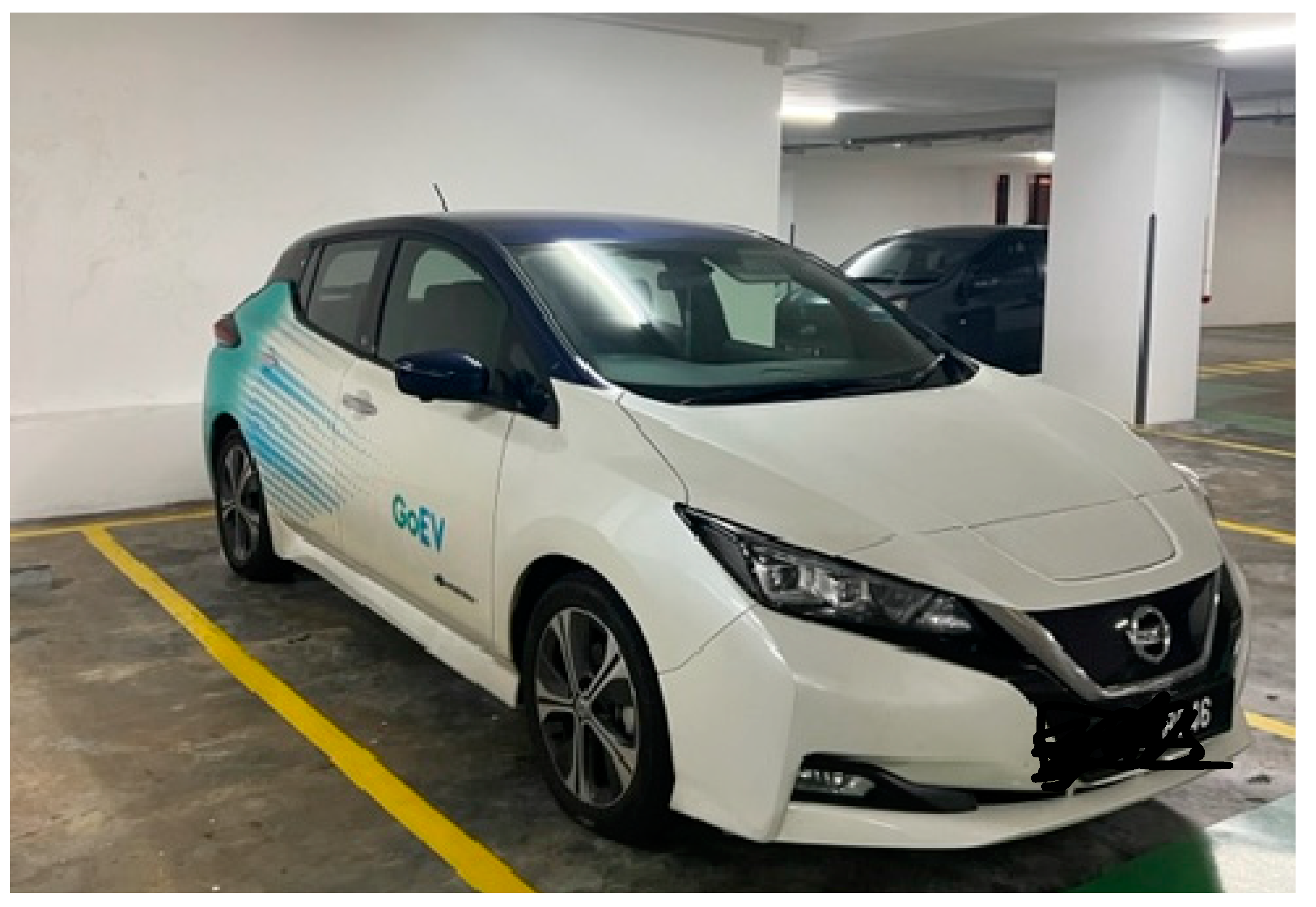
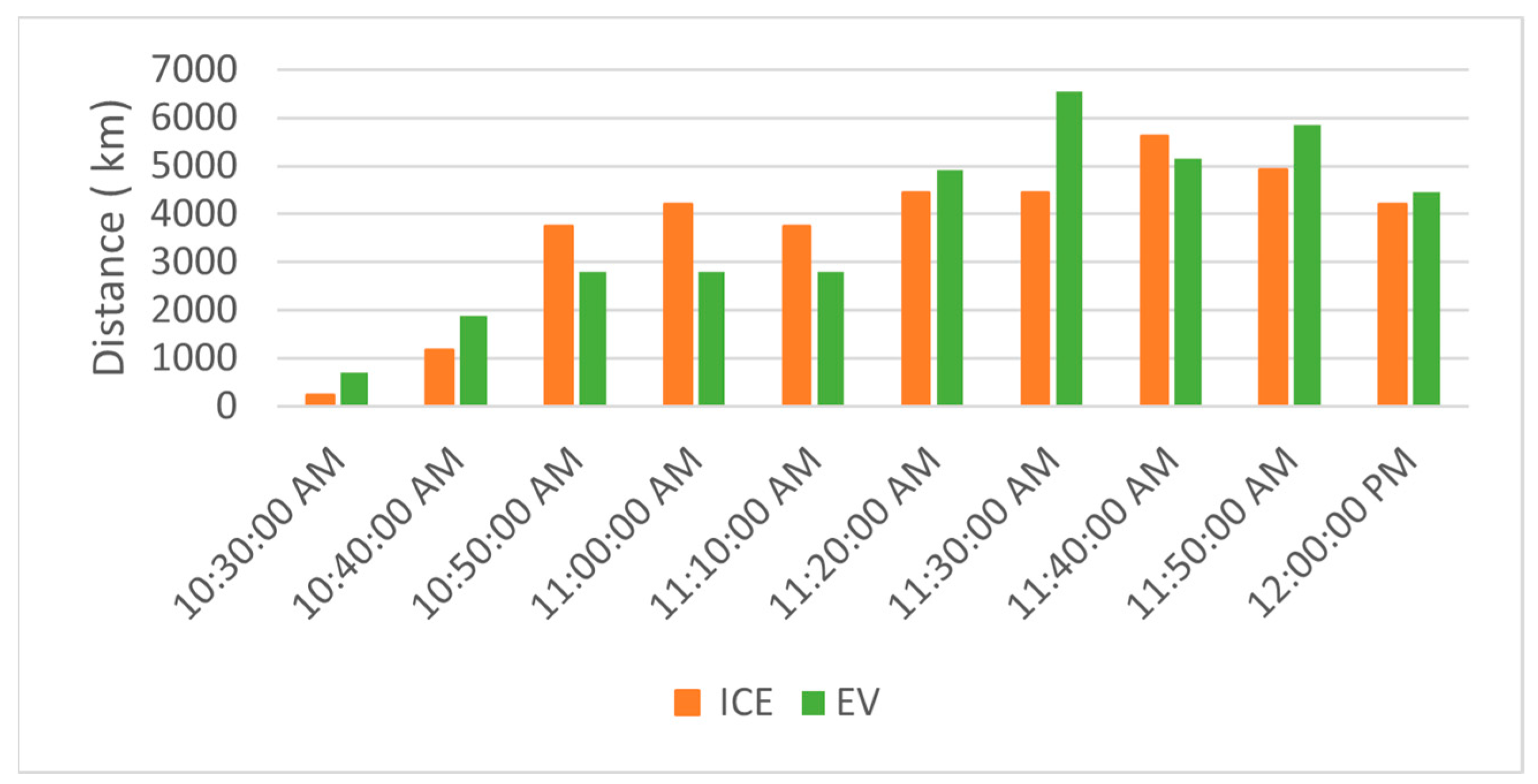
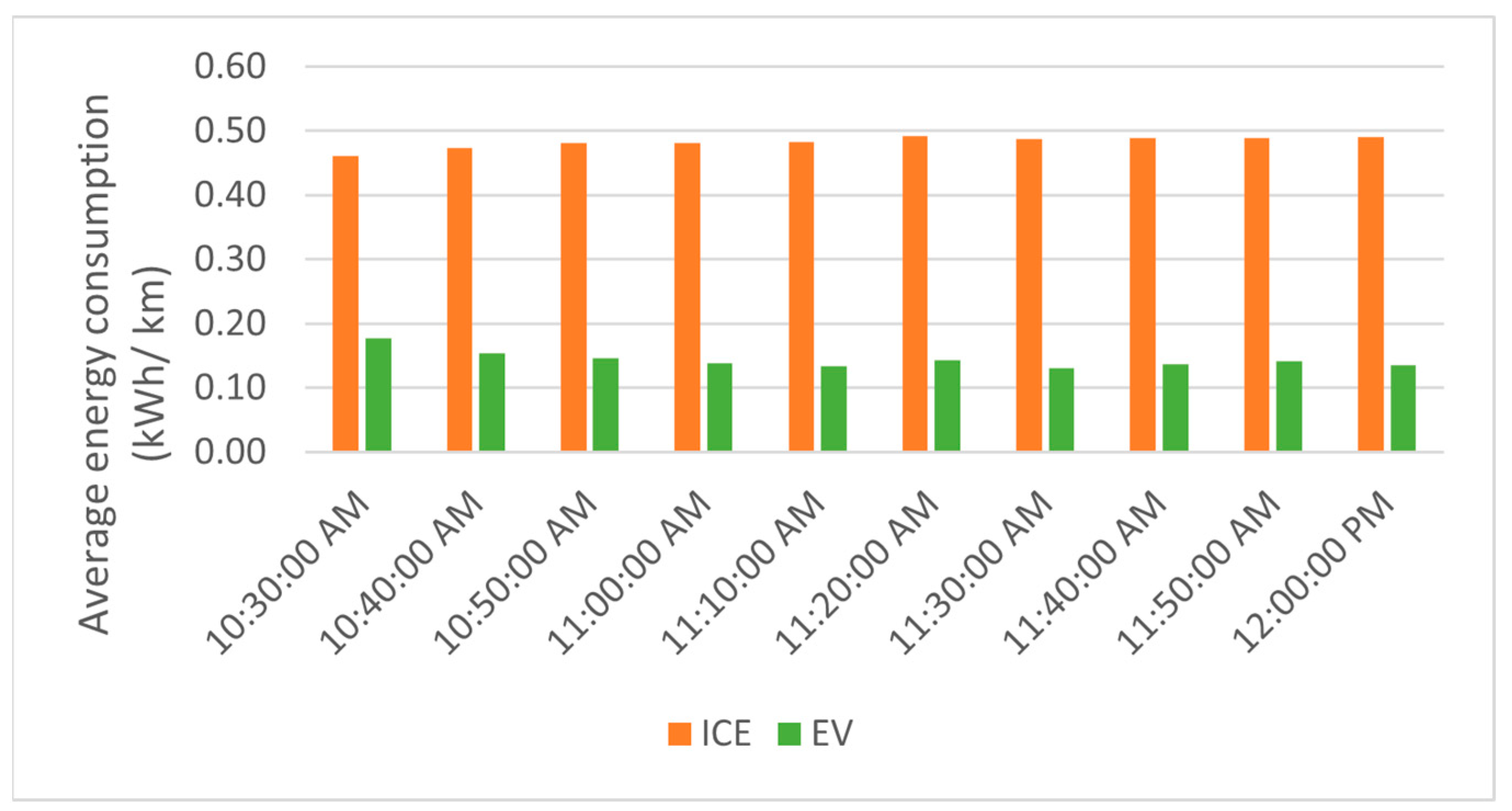



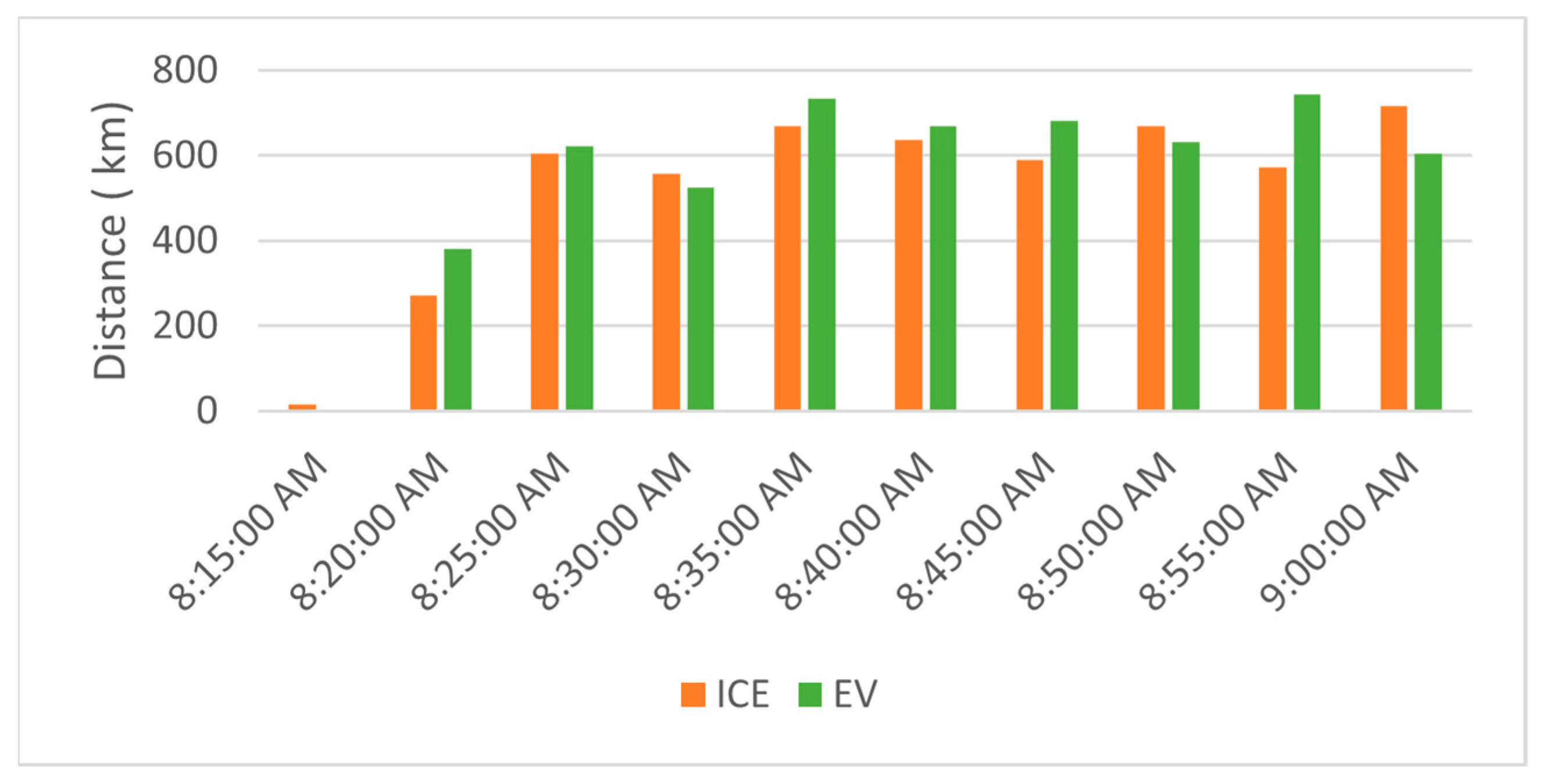
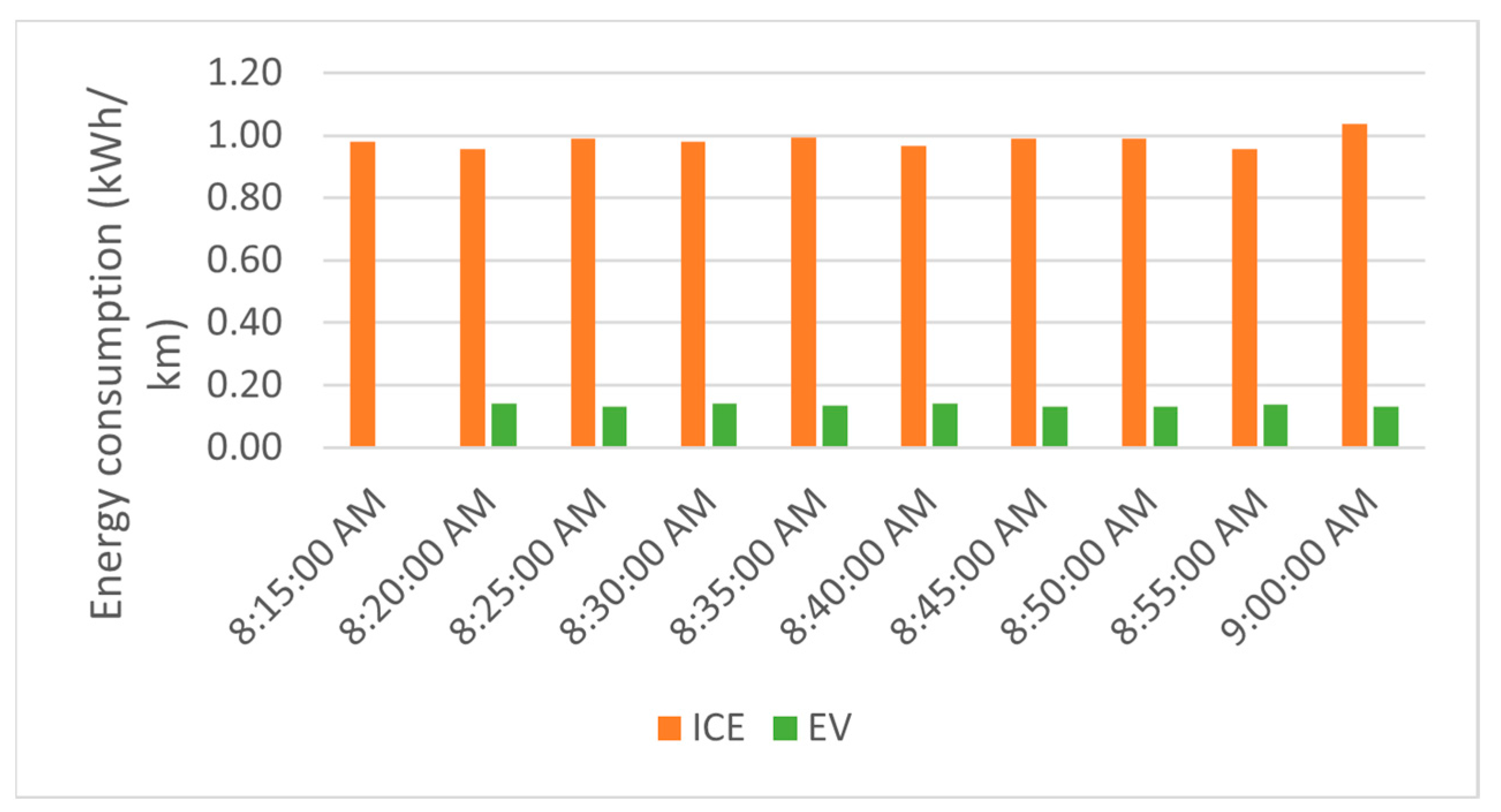


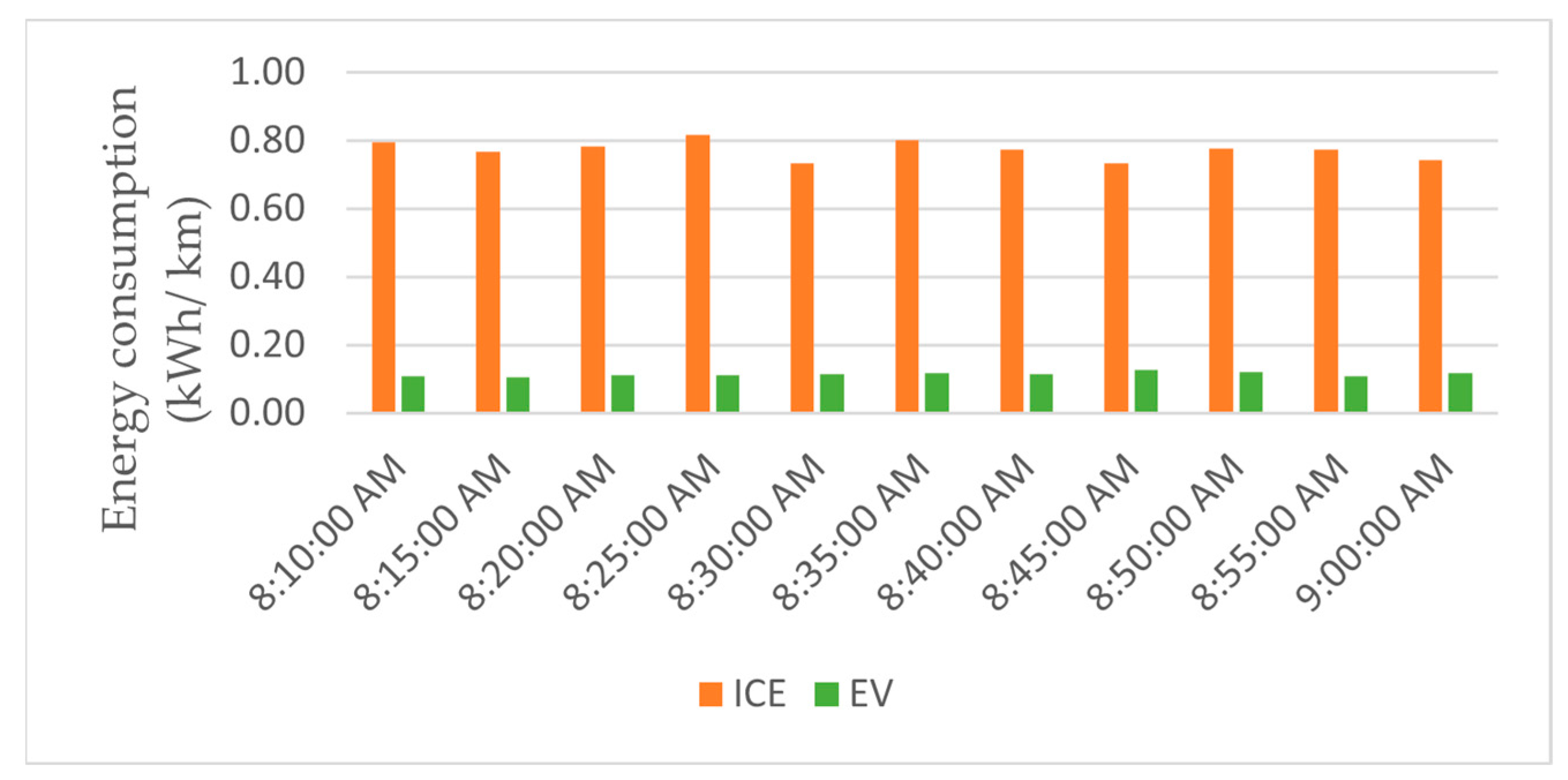
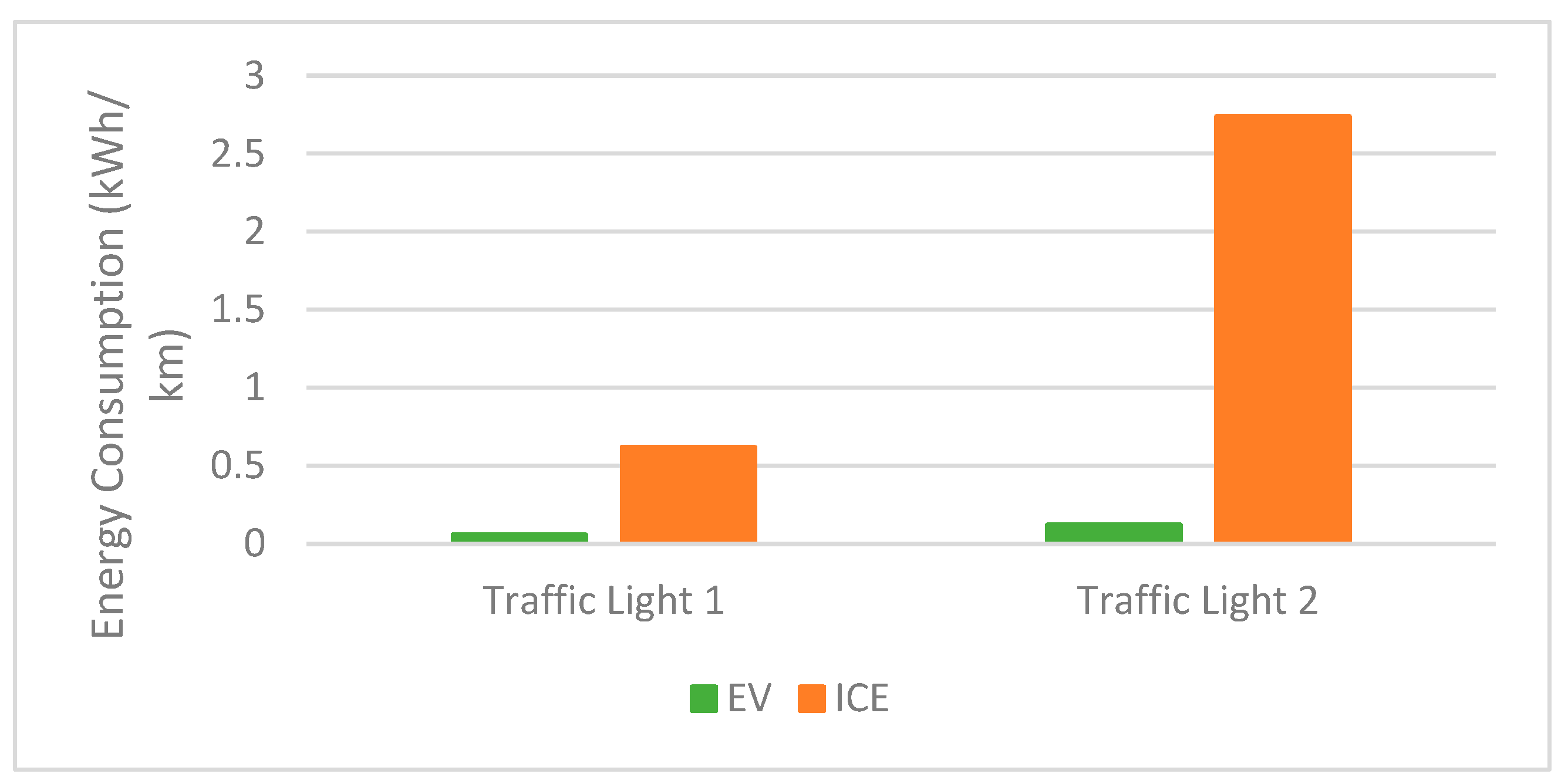
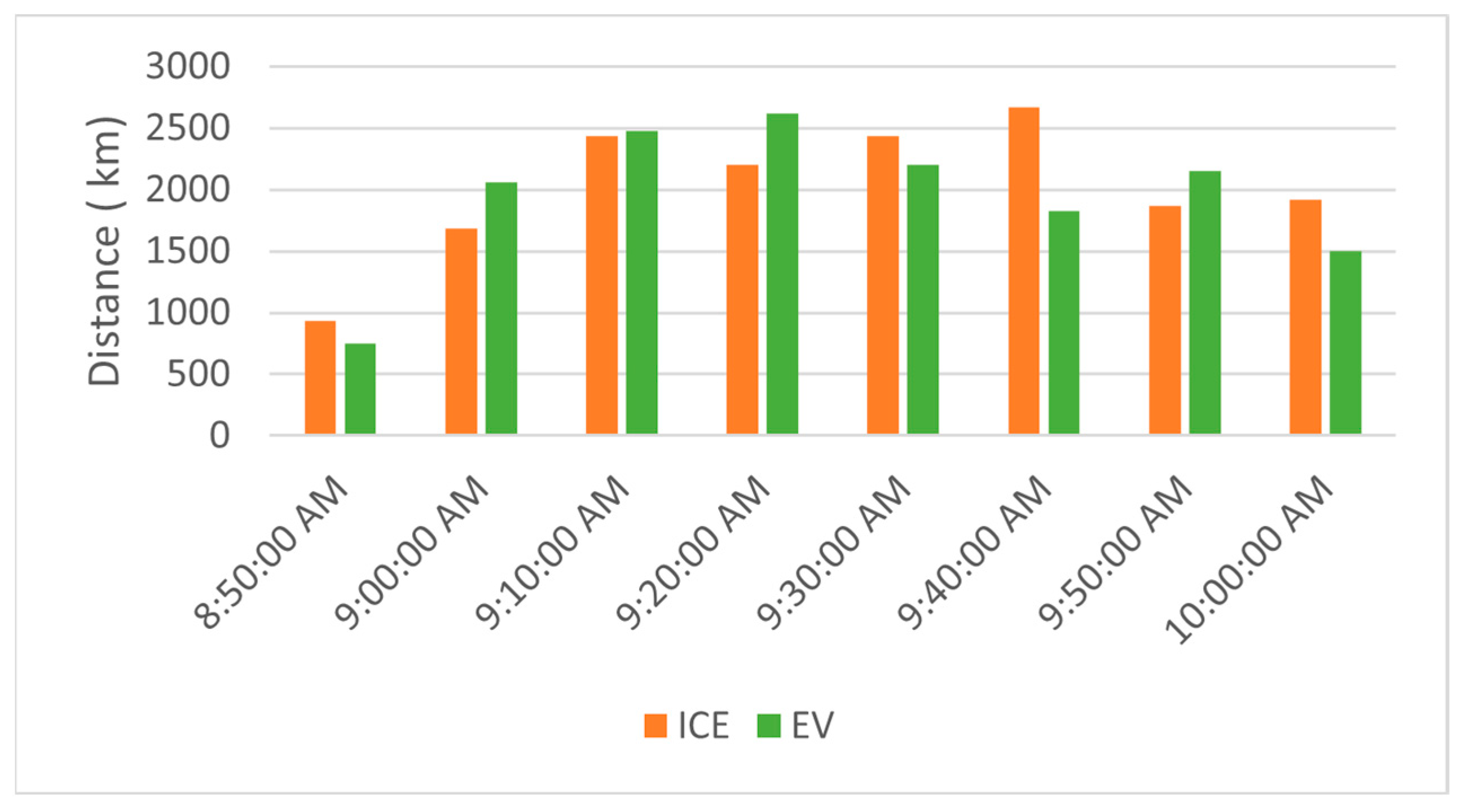
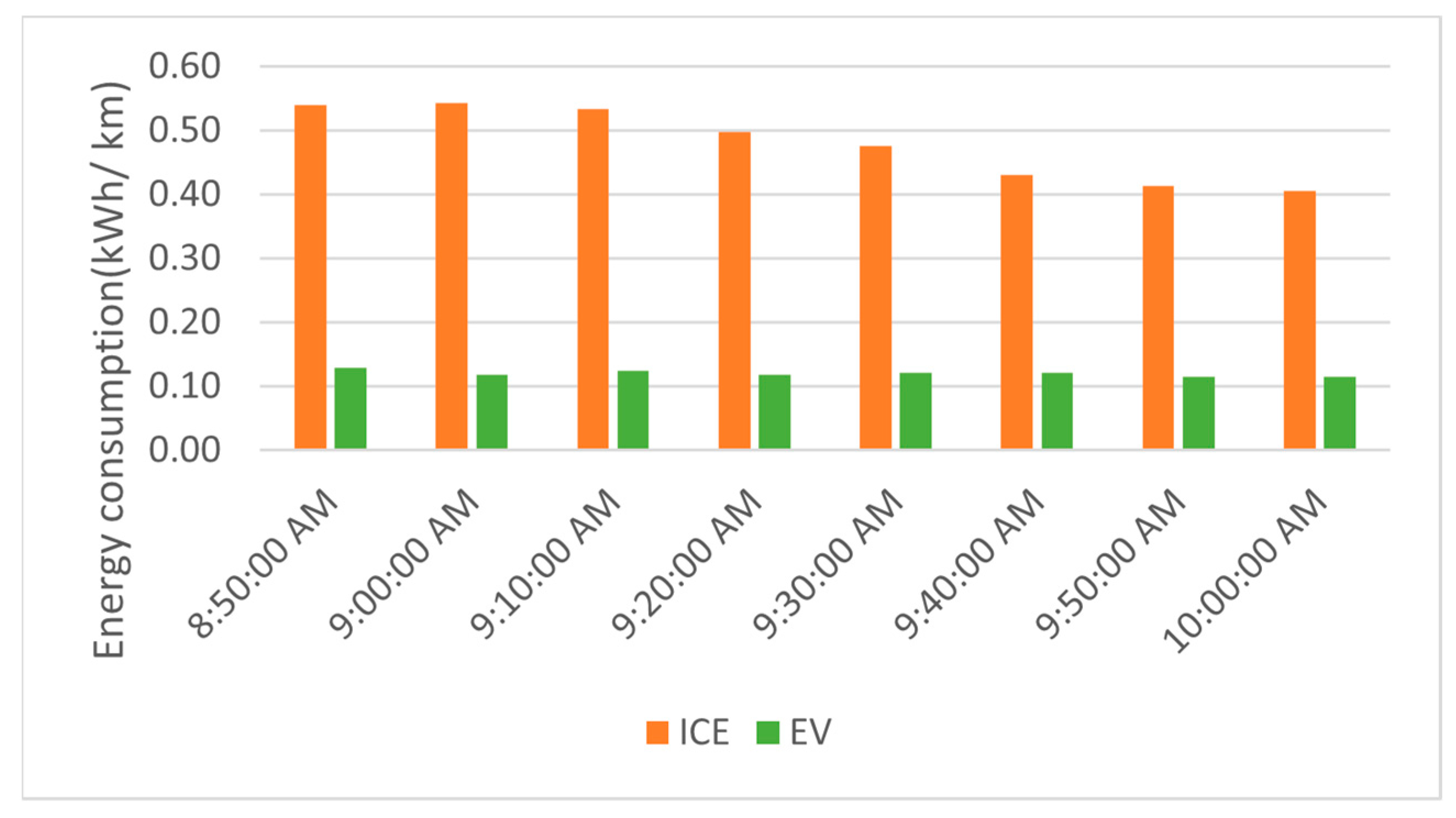
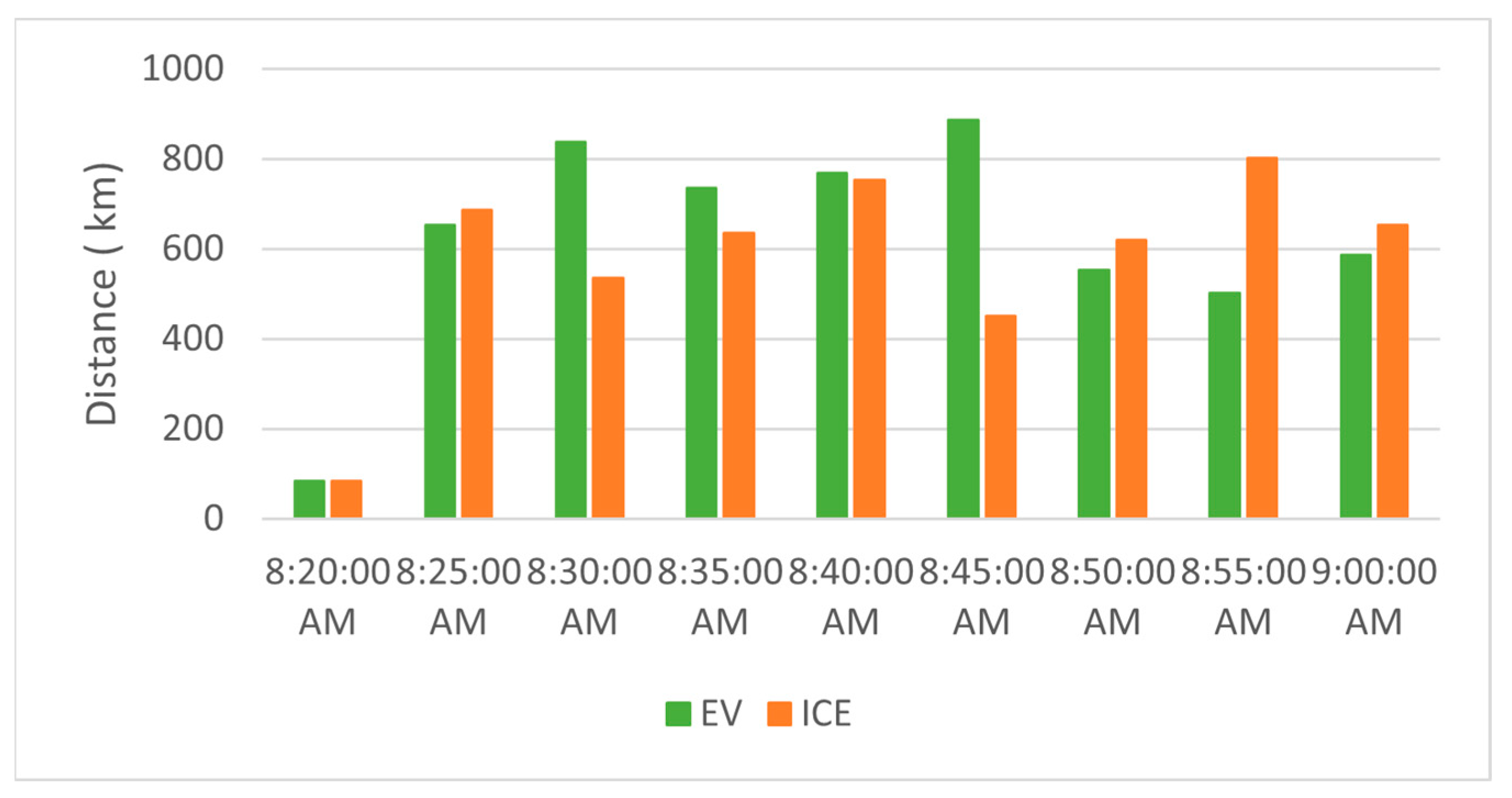
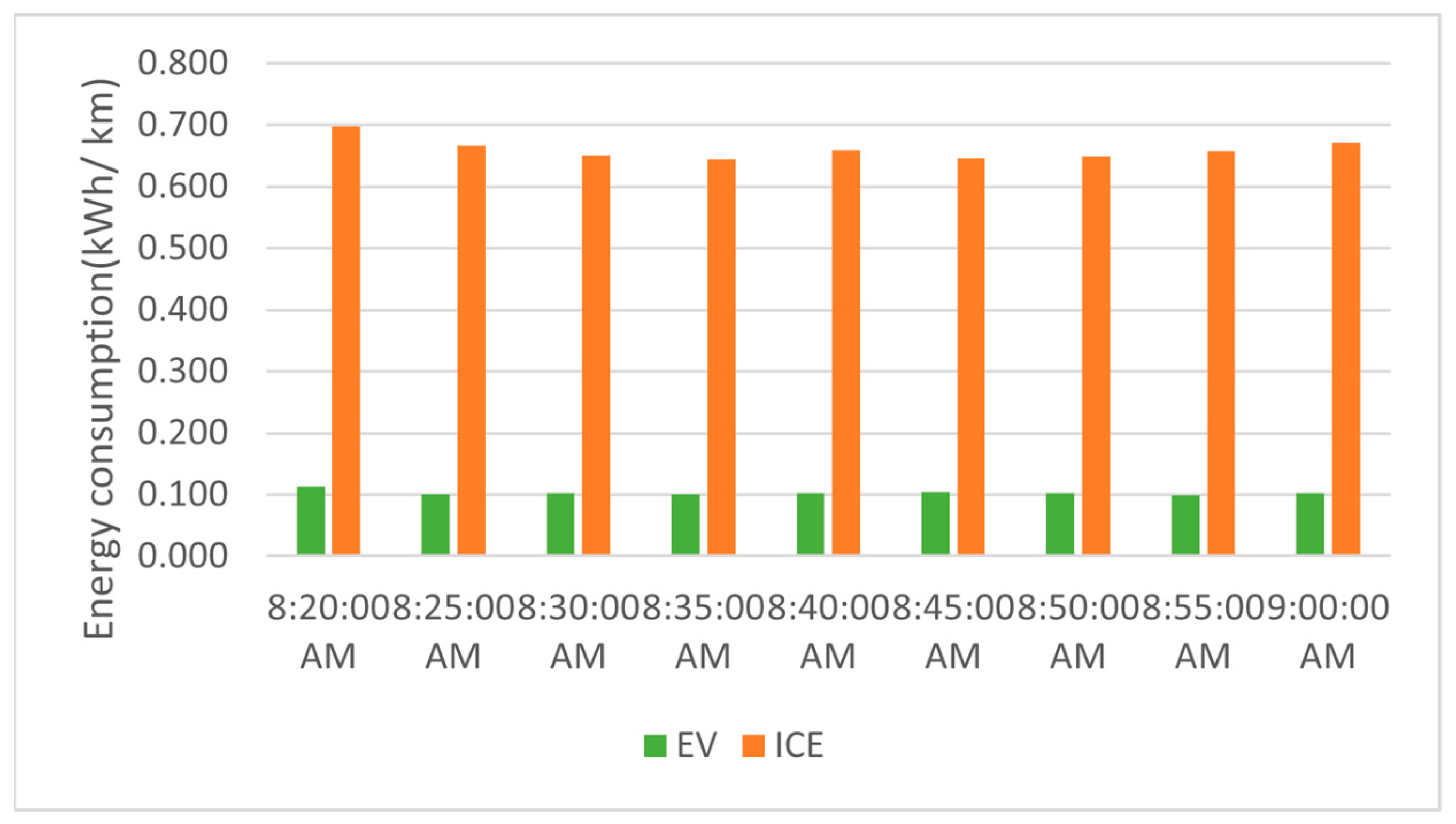
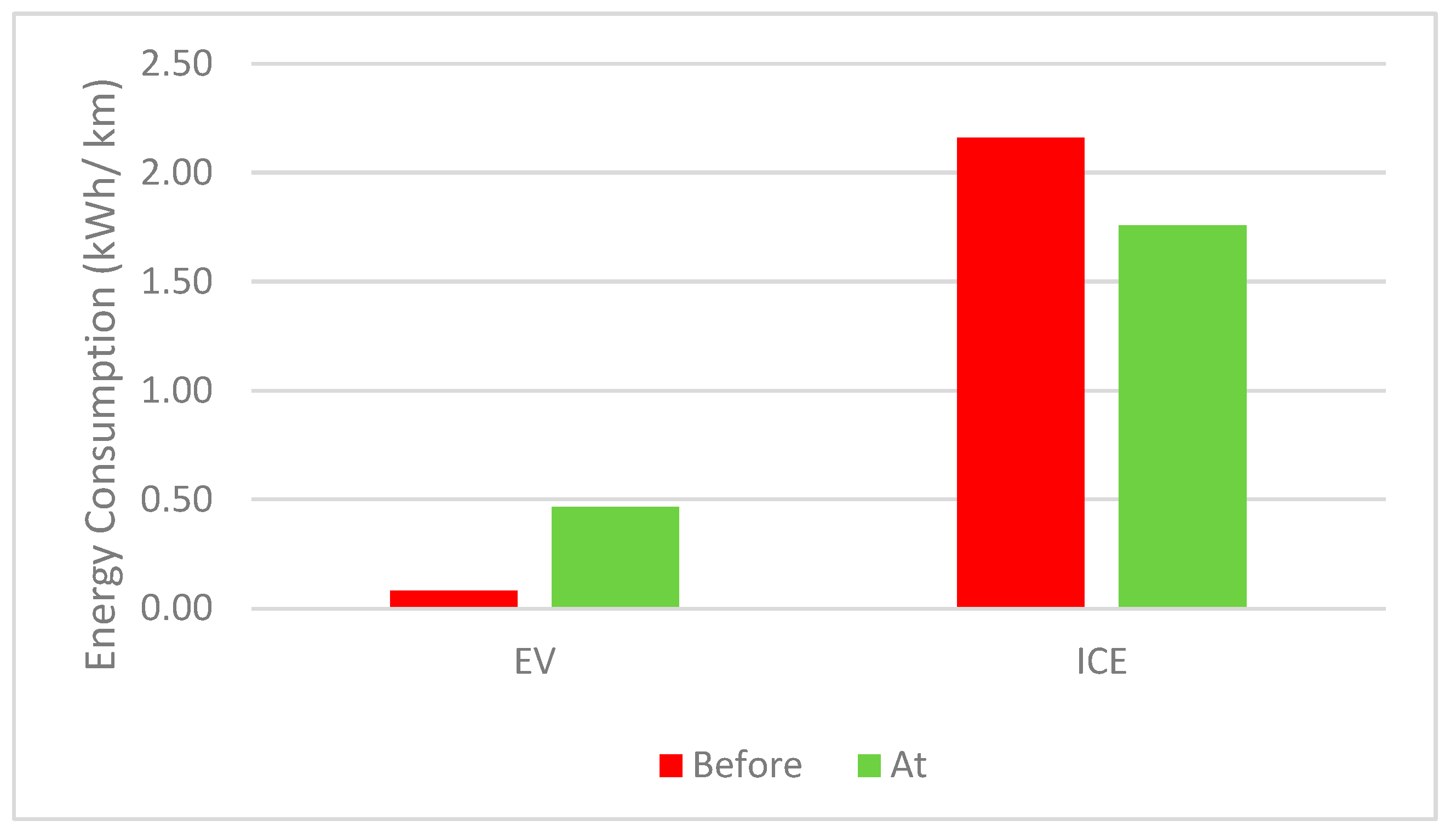
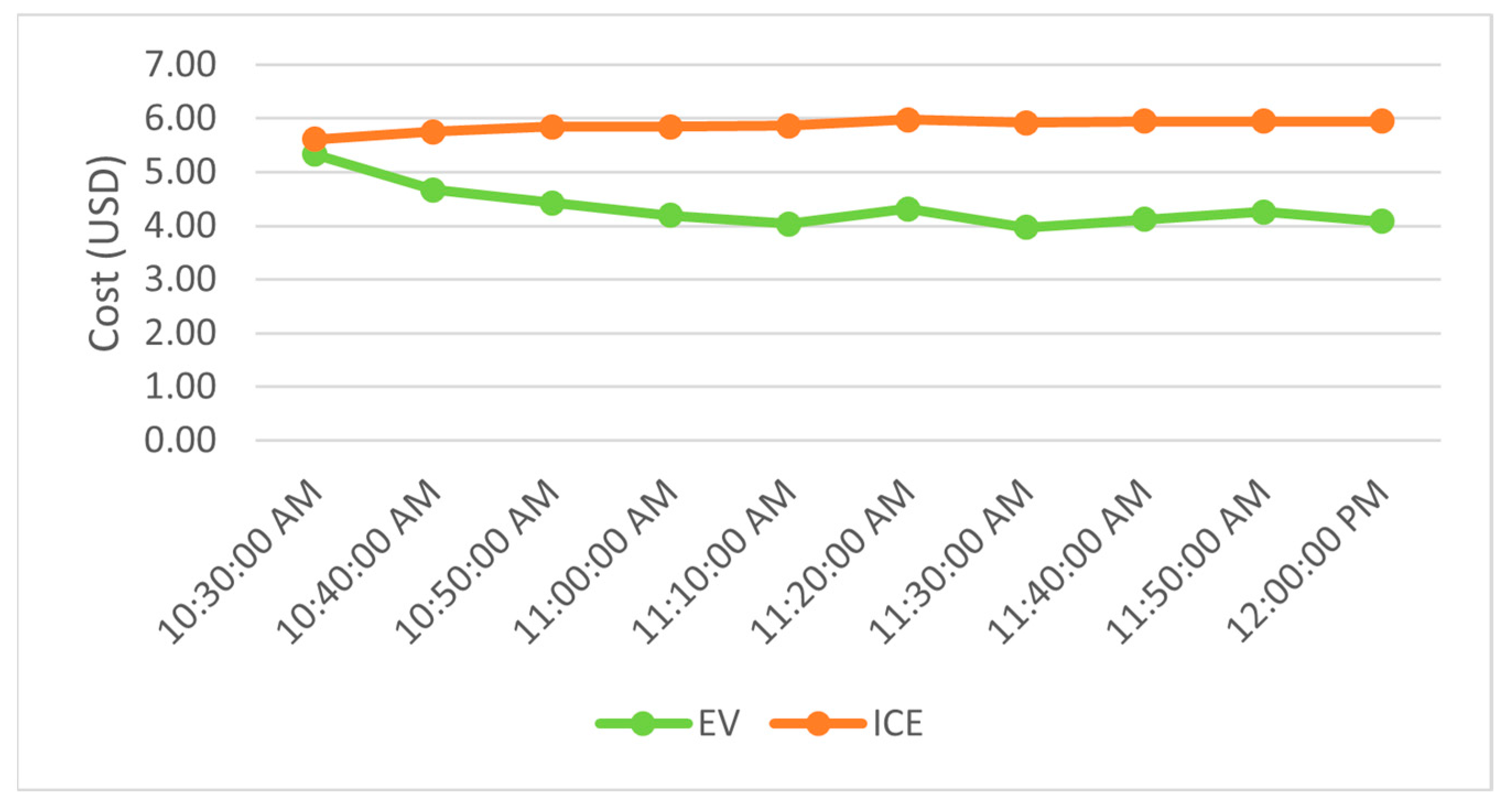
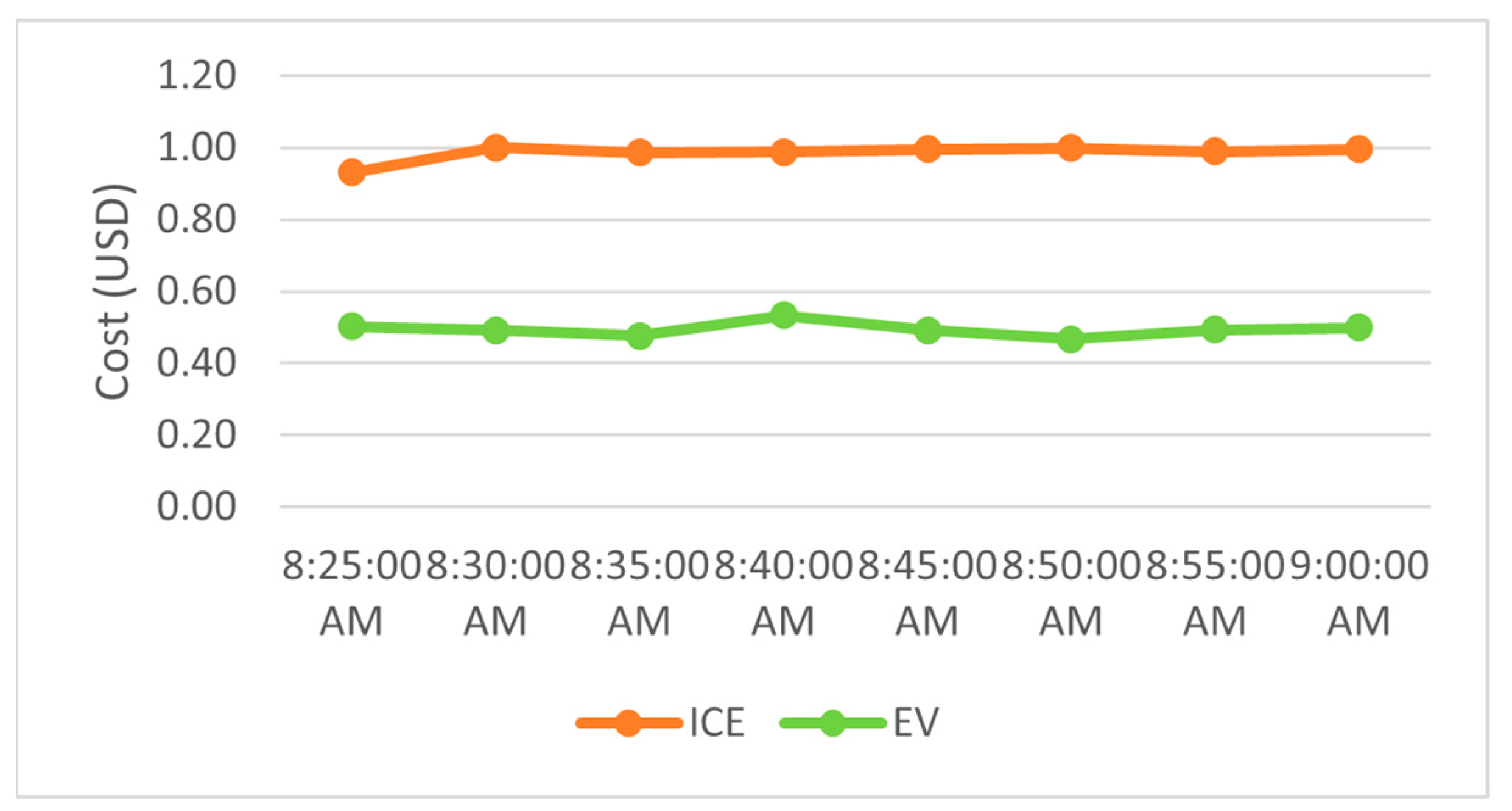
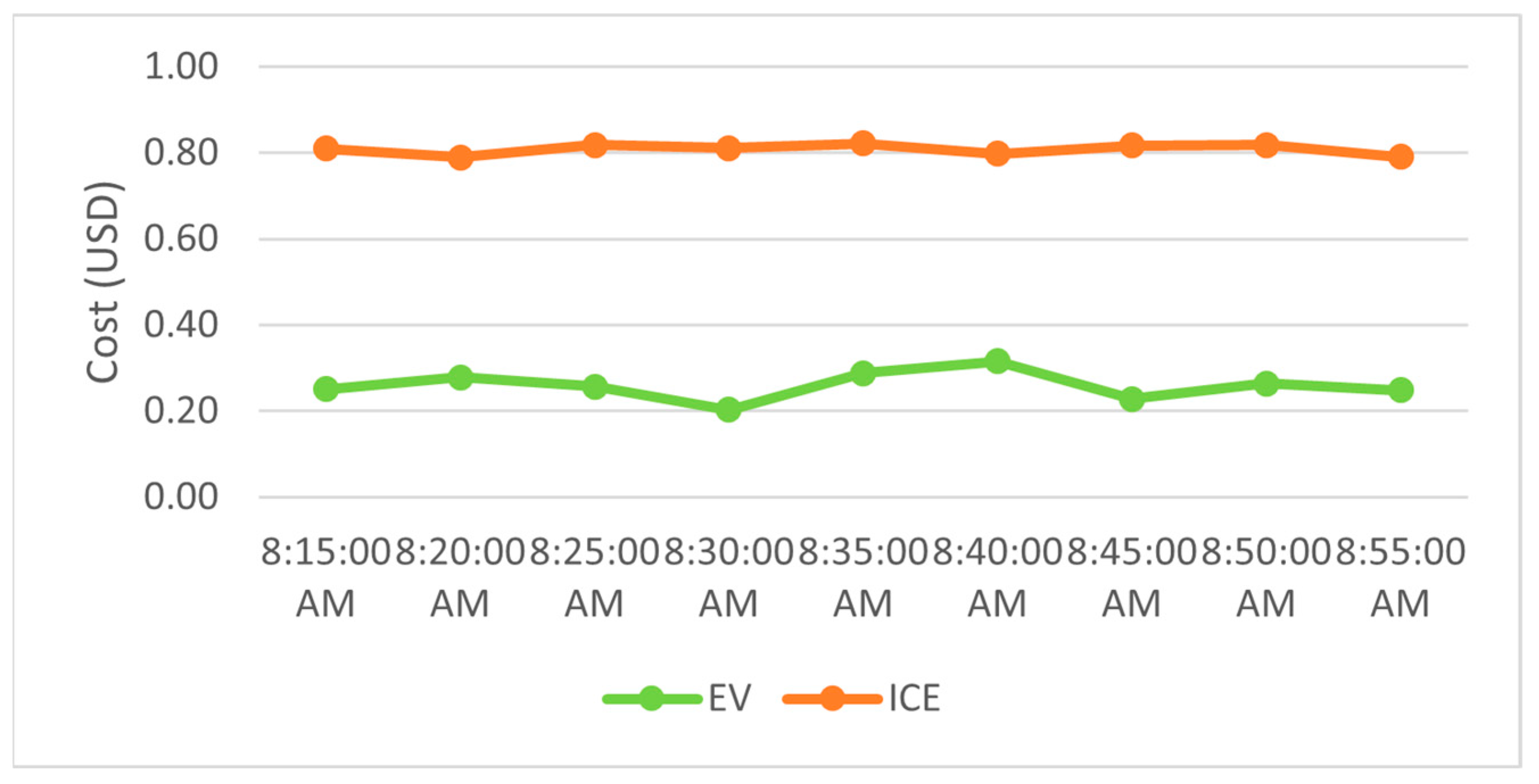

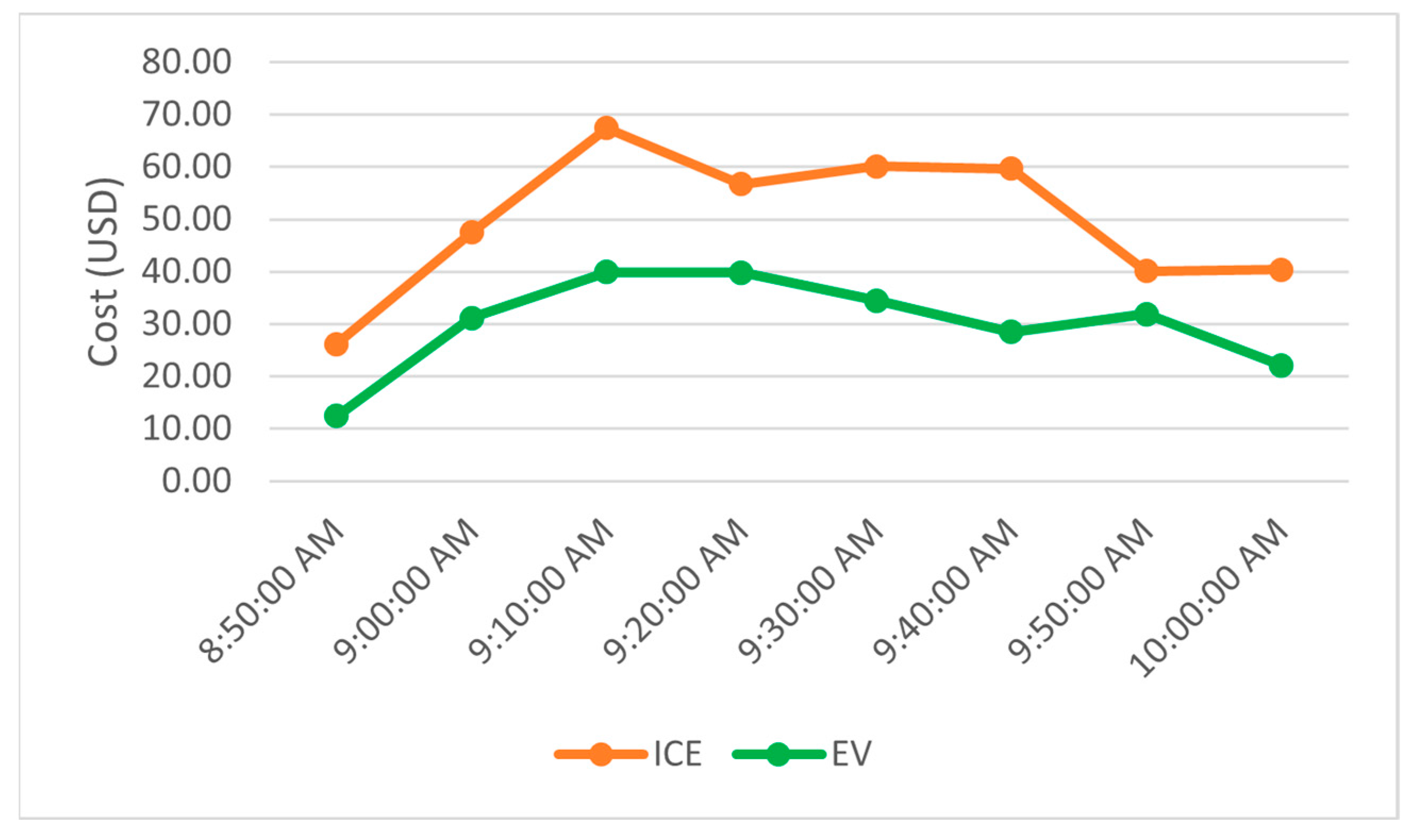

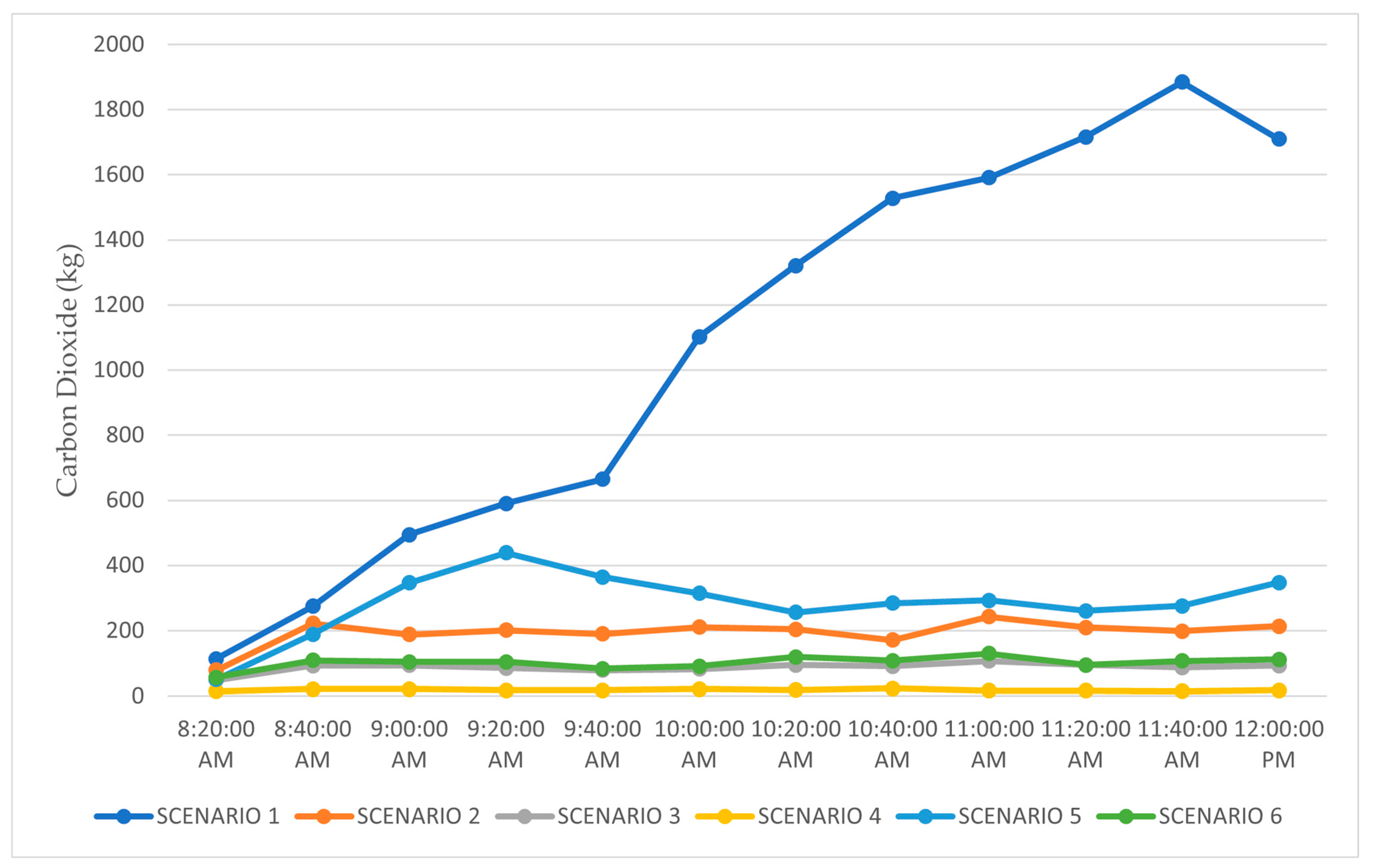
| Tariff Category (Residential) | Current Rate (Cent/kWh) |
|---|---|
| For the first 200 kWh (1–200 kWh) per month | 0.049 |
| For the next 100 kWh (201–300 kWh) per month | 0.075 |
| For the next 300 kWh (301–600 kWh) per month | 0.12 |
| For the next 300 kWh (601–900 kWh) per month | 0.12 |
| For the next kWh (901 kWh onwards) per month | 0.13 |
| Fi (Idling) | 0.330 mL/s |
|---|---|
| F1 (at 90 km/h) | 4.700 L/100 km |
| F2 (at 120 km/h) | 5.400 L/100 km |
| C1 (Accelerating) | 0.26 mL/s |
| C2 (Accelerating) | 0.42 mls2/m2 |
| Fd (Decelerating) | 0.53 mL/s |
| Minimum Consumption Speed: Vm | 50 km/h |
| Pollutant | CO2 |
|---|---|
| Fuel Type | Petrol |
| Lower Limit | - |
| Factor 1 | |
| Factor 2 | |
| Factor 3 | |
| Factor 4 | |
| Factor 5 | |
| Factor 6 |
| Description | Photo |
|---|---|
| Scenario 2 initial odometer reading | 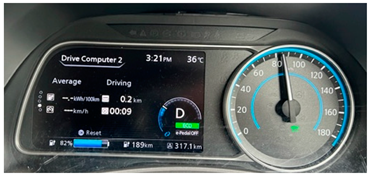 |
| Driving from origin of Scenario 2 to the destination | 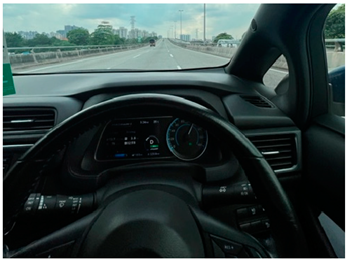 |
| Arrived at Scenario 2 destination | 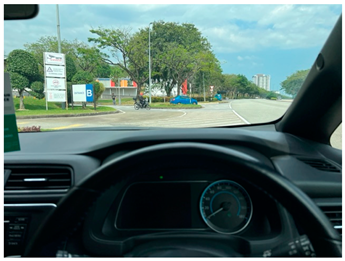 |
| Odometer reading at the destination | 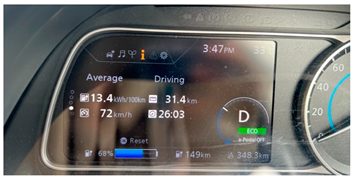 |
| Scenario | 1 | 2 | 3 | 4 | 5 | 6 |
|---|---|---|---|---|---|---|
| CO2 emission by ICEVs (kg) | 12,989.43 | 2333.82 | 1055.02 | 224.86 | 3421.11 | 1224.90 |
| CO2 emission by EVs (kg) | 2908.26 | 1065.03 | 564.56 | 80.97 | 1279.71 | 487.19 |
| Scenario | Total Distance (km) | Energy Consumption (kWh/km) | Energy Saving | Cost SAVING | ||
|---|---|---|---|---|---|---|
| EVs | ICE | EVs | ICE | |||
| 1 | 37,933.37 | 36,762.57 | 0.14 | 0.48 | 30% | 26% |
| 2 | 9611.31 | 8390.15 | 0.12 | 0.61 | 80% | 41% |
| 3 | 605.27 | 716.66 | 0.14 | 0.98 | 86% | 64% |
| 4 | 1289.48 | 1229.37 | 0.11 | 0.77 | 85% | 61% |
| 5 | 1497.54 | 1918.77 | 0.12 | 0.48 | 75% | 39% |
| 6 | 585.50 | 652.44 | 0.10 | 0.66 | 84% | 59% |
| Scenario | Distance Traveled (km) | Average Speed (km/h) | Time to Destination (min) | |||
|---|---|---|---|---|---|---|
| AIMSUN | Experiment | AIMSUN | Experiment | AIMSUN | Experiment | |
| 2 | 31.3 | 31.4 | 75.7 | 72 | 25 | 26 |
| 3 | 13.6 | 15.1 | 51 | 23 | 20 | 38 |
| 4 | 2.70 | 2.50 | 25.36 | 21 | 10 | 7.25 |
| Scenario | Energy Consumption (kWh/km) (AIMSUN) | Energy Consumption (kWh/km) (EXPERIMENT) |
|---|---|---|
| 2 | 0.12 | 0.14 |
| 3 | 0.14 | 0.13 |
| 4 | 0.11 | 0.14 |
Disclaimer/Publisher’s Note: The statements, opinions and data contained in all publications are solely those of the individual author(s) and contributor(s) and not of MDPI and/or the editor(s). MDPI and/or the editor(s) disclaim responsibility for any injury to people or property resulting from any ideas, methods, instructions or products referred to in the content. |
© 2023 by the authors. Licensee MDPI, Basel, Switzerland. This article is an open access article distributed under the terms and conditions of the Creative Commons Attribution (CC BY) license (https://creativecommons.org/licenses/by/4.0/).
Share and Cite
Muzir, N.A.Q.; Hasanuzzaman, M.; Selvaraj, J. Modeling and Analyzing the Impact of Different Operating Conditions for Electric and Conventional Vehicles in Malaysia on Energy, Economic, and the Environment. Energies 2023, 16, 5048. https://doi.org/10.3390/en16135048
Muzir NAQ, Hasanuzzaman M, Selvaraj J. Modeling and Analyzing the Impact of Different Operating Conditions for Electric and Conventional Vehicles in Malaysia on Energy, Economic, and the Environment. Energies. 2023; 16(13):5048. https://doi.org/10.3390/en16135048
Chicago/Turabian StyleMuzir, Nur Ayeesha Qisteena, Md. Hasanuzzaman, and Jeyraj Selvaraj. 2023. "Modeling and Analyzing the Impact of Different Operating Conditions for Electric and Conventional Vehicles in Malaysia on Energy, Economic, and the Environment" Energies 16, no. 13: 5048. https://doi.org/10.3390/en16135048
APA StyleMuzir, N. A. Q., Hasanuzzaman, M., & Selvaraj, J. (2023). Modeling and Analyzing the Impact of Different Operating Conditions for Electric and Conventional Vehicles in Malaysia on Energy, Economic, and the Environment. Energies, 16(13), 5048. https://doi.org/10.3390/en16135048








